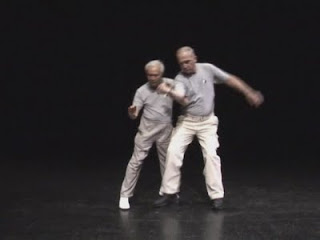The left shoulder of Master Master Stephen Hwa "offsets" the opponents' equilibrium, observation shows this."Shouldering" is 靠 (kào). The pronunciation is something like "cow."The meaning of 靠 (kào) in Tai Chi is to use your body to bump or press against something. "Shoulder" is used, but the word "Kao" actually does not mean "shoulder" specifically. It seems "old" as a word, perhaps traditional where "one word is used for many things* as Master Hwa has explained "The teacher forgot his keys and used "Kao" from his back to get into the office", unfortunately rendering the door useless, Master Hwa used "Kao" with his shoulder to bump his tall student Jim Roach. Master Stephen Hwa used Kao with his back to bump someone's chest that tried to get him in a bearhug from behind. Sifu Jim Roach was carrying a package and had to move a chair out of the way by using "Kao" to bump it with his derriere. Jack Eichel body checked the opponent into the "boards", and in Chinese, this would be called "Kao Not shown for Master Wu is only the beginning of and not how fluid a followup move to Part the Wild Horse’s Mane 野馬分鬃. Note the position of Master Wu's left knee as a "fulcrum". I did this application with classmates at Wu's Tai Chi Academy in Toronto quite a bit...very adaptable and efficient.
Wednesday, May 20, 2020
靠 (kào) Shoulder
The left shoulder of Master Master Stephen Hwa "offsets" the opponents' equilibrium, observation shows this."Shouldering" is 靠 (kào). The pronunciation is something like "cow."The meaning of 靠 (kào) in Tai Chi is to use your body to bump or press against something. "Shoulder" is used, but the word "Kao" actually does not mean "shoulder" specifically. It seems "old" as a word, perhaps traditional where "one word is used for many things* as Master Hwa has explained "The teacher forgot his keys and used "Kao" from his back to get into the office", unfortunately rendering the door useless, Master Hwa used "Kao" with his shoulder to bump his tall student Jim Roach. Master Stephen Hwa used Kao with his back to bump someone's chest that tried to get him in a bearhug from behind. Sifu Jim Roach was carrying a package and had to move a chair out of the way by using "Kao" to bump it with his derriere. Jack Eichel body checked the opponent into the "boards", and in Chinese, this would be called "Kao Not shown for Master Wu is only the beginning of and not how fluid a followup move to Part the Wild Horse’s Mane 野馬分鬃. Note the position of Master Wu's left knee as a "fulcrum". I did this application with classmates at Wu's Tai Chi Academy in Toronto quite a bit...very adaptable and efficient.
Sunday, May 10, 2020
"They don't want to do the work"!
Core moves and hand pushes forward
A student’s son once asked: "Why aren't there more
people in class"? I responded, "(for one "good/bad" reason
or another)...because they do not want to do the work..." That is the
nitty-gritty of what I'm about to say here and why I have seen so many students
come and go in 40+ years. I started learning Tai Chi in 1976 and heard from the
start that it was “internal”.
What I got was teaching that “talked a good game
about internal” and I always felt empty. It was only 28 years later that I
encountered this level of sophistication in movement. Try this and like playing
the piano, just move the ring finger up and down repetitively. Being honest,
notice how the other fingers move "extraneously" even ever so
slightly
On a larger scale, this is the problem one faces with what happens
when you learn 1/4 (upper quadrant of core/torso) as Master Hwa shows here. One
part moves ok, but the other half of the upper quadrant "chimes" in
extraneously and drains off the power of the part you want to move.
Piano players
face the “extraneous” movement conundrum constantly and have to do designed
finger exercises to overcome it The same attention to detail, doing exactly as
Master Hwa does here over and over and over, etc., is the way to practice ¼, ½
body movement and holds true for learning “internal” in Tai Chi.
Subscribe to:
Comments (Atom)
Large v Small
Large Frame Tai Chi Tai Chi Large/Small Dr. Hwa, I purchased your videos several years ago, and while I do the Yang , large movements, tr...
-
Very interesting post! But my Taiwanese sources tell me, that Xiong Yanghe's Taijiquan has many origins, from some nephew of Yang Luch...
-
Yielding Sit Back Video Link When I “Take the opponent higher” I sit back but there is a “tilt”. I am in “sit back” and yielding” in respo...

05-20-05%5D.JPG)

